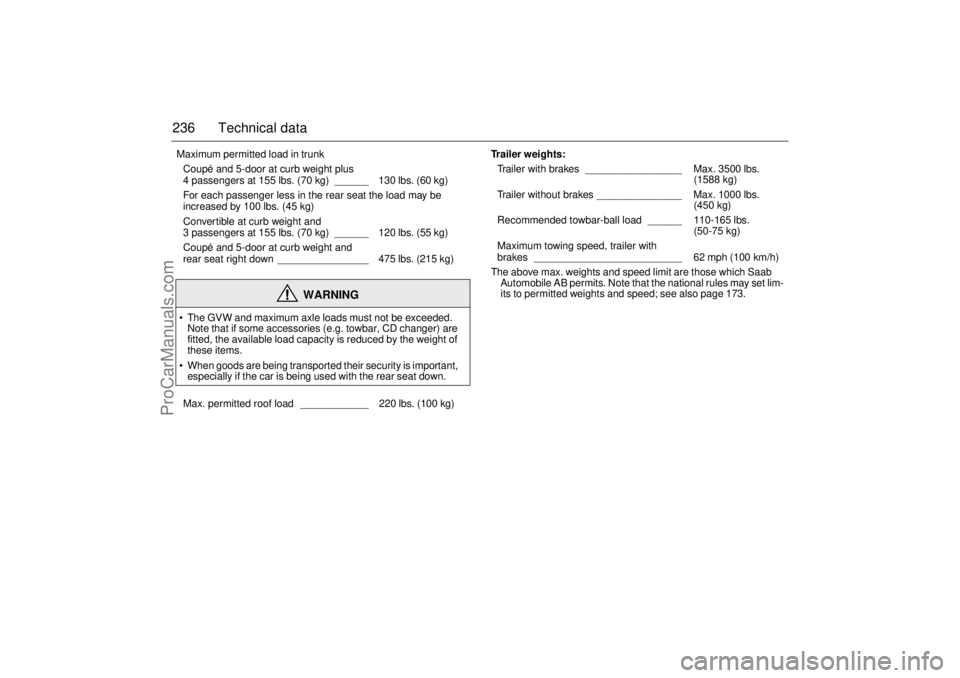ESP SAAB 9-3 2002 Owner's Guide
[x] Cancel search | Manufacturer: SAAB, Model Year: 2002, Model line: 9-3, Model: SAAB 9-3 2002Pages: 256, PDF Size: 11.55 MB
Page 231 of 256

231 Maintenance and owner assistance
Service record retentionService instruction coupons and record
stubs are provided in the Saab Warranties
and Service Record Booklet which accom-
panies this Owner’s Manual. The coupons
are arranged in the order that normal ser-
vice should be performed. The edge of each
coupon is shaded to correspond to the type
of service point:
Striped - "Check-up".
Blue - Oil change/inspection service.
Black - Major service.
Note that in Canada a combined service
and warranty book is used, but not service
coupons.
When scheduled services are performed,
your dealer will tear out the applicable
coupon and use it to check off the opera-
tions performed and enter it into the service
file at the dealership. The servicing dealer’s
stamp, along with the date and mileage at
which the service was done, should be
entered on the corresponding stub which
remains in your booklet. The booklet is your
permanent record of the services per-
formed. It also includes a log sheet for
unscheduled repairs.
It is advisable to retain receipts and, if pos-
sible, copies of shop work orders for all ser-
vice and repair work, wherever performed.
Service costsDealer pricing practices and labor for ser-
vice work vary. Saab’s recommended ser-
vice times for each service point do not
include the labor required to replace wear
items, such as wiper blades, brake pads or
tires. Nor is labor to perform other service or
repairs found to be necessary as a result of
the inspections included in these times.
Additional labor and parts will be charged
for such work when necessary, except as
covered under an applicable Saab warranty
or any optional extended service contract.
Transmission fluid changes or suspension
alignment, when necessary, are also addi-
tional.
Dealer charges for general shop material,
regulated hazardous waste removal, recy-
cling expenses or other operation costs may
also be applied to service and repair
invoices and are apt to vary by dealer and
location.
Owner assistanceWarranties and service problem
assistanceFor complete information about all applica-
ble warranties, including the New Car War-
ranty, Perforation Warranty, Vehicle Emis-
sion Warranty and Emission Perforation
Warranty, consult the Warranties and Ser-
vice Record Booklet which accompanies
this Owner’s Manual. It also contains owner
assistance information including Saab
Roadside Assistance. If the booklet is lost or
misplaced, a new one may be ordered
through a Saab dealer or by contacting
Saab.
In the U.S. there is a national Customer
Assistance Center at Saab Cars USA, Inc.
The toll-free number to call from all 50 states
is 1-800-955-9007.
In Canada, please call the Saab Customer
Assistance Centre at 1-800-263-1999.
A list of authorized Saab sales and service
dealers is available for those planning to
travel in the United States and Canada.
Canadian or U.S. travelers may call the
Customer Assistance Center in the country
in which they are traveling.
ProCarManuals.com
Page 236 of 256

236 Technical data Maximum permitted load in trunk
Coupé and 5-door at curb weight plus
4 passengers at 155 lbs. (70 kg) ______ 130 lbs. (60 kg)
For each passenger less in the rear seat the load may be
increased by 100 lbs. (45 kg)
Convertible at curb weight and
3 passengers at 155 lbs. (70 kg) ______ 120 lbs. (55 kg)
Coupé and 5-door at curb weight and
rear seat right down ________________ 475 lbs. (215 kg)
WARNING
The GVW and maximum axle loads must not be exceeded.
Note that if some accessories (e.g. towbar, CD changer) are
fitted, the available load capacity is reduced by the weight of
these items.
When goods are being transported their security is important,
especially if the car is being used with the rear seat down.
Max. permitted roof load ____________ 220 lbs. (100 kg)
Trailer weights:
Trailer with brakes _________________ Max. 3500 lbs.
(1588 kg)
Trailer without brakes _______________ Max. 1000 lbs.
(450 kg)
Recommended towbar-ball load ______ 110-165 lbs.
(50-75 kg)
Maximum towing speed, trailer with
brakes __________________________ 62 mph (100 km/h)
The above max. weights and speed limit are those which Saab
Automobile AB permits. Note that the national rules may set lim-
its to permitted weights and speed; see also page 173.
ProCarManuals.com
Page 237 of 256

237 Technical data
Engine Engine oilType _____________________________ 4 cyl, 2 overhead
camshafts,
16 valves and 2 bal-
ancer shafts
Cylinder bores ______________________ 3.54" (90 mm)
Stroke:
2.0 Turbo _________________________ 3.071" (78 mm)
Viggen __________________________ 3.543” (90 mm)
Swept volume:
2.0 Turbo _________________________ 121 cu.in.
(1,985 dm
3)
Viggen __________________________ 140 cu.in.
(2.290 dm3)
Idling speed _______________________ 900 rpm
Antifreeze _________________________ Saab-approved
antifreeze
Coolant volume, cooling system ________ 8.7 qts. (8.5 l)
Oil recommendation: We recommend the use of oils that are available from your
Saab dealer, for regular oil changes. These oils fulfill the most
stringent requirements set by API and ACEA classifications.
Basic recommendations for Saab engines
SAE 5W-30 or 0W-30, 5W-40.
The oil should be semi or fully synthetic and fulfill grade re-
quirements for ACEA A3/B3, API SJ or higher. In addition to API
and ACEA the ILSAC GF-3 specification is approved for use in
applicable markets.
Fully synthetic oils with viscosity’s 0W-40/50 of well known
brands and fulfilling minimum ACEA A3/B3 are also recom-
mended, especially for extreme driving conditions.
ProCarManuals.com
Page 238 of 256

238 Technical dataOil specification
Oil for gasoline engines is classified by the API (American Pe-
troleum Institute) and ACEA (European Automobile Manufac-
turers Associations) standards.
API classifies engine oil into grade classes SH (since 1993) and
SJ (since 1996). The SJ class fulfils more stringent require-
ments and has lower phosphorous level. A new grade API SL,
introduced 2001, fulfils even higher requirements.
These grade classes are most often combined with correspond-
ing classes for diesel engines. The class designations for diesel
engines begins with the letter "C" (Commercial). For example a
grade combination suitable for both types of engine could be
API SH/CD, SJ/CF or SL/CF.
Under the ACEA nomenclature, oils are divided into Class A for
gasoline engines and Class B for diesel engine passenger cars.
There is a further class for heavy diesel engines. Each class is
divided into grades: 1,2 and 3 where grades 2 and 3 normally
encompass semi- and fully synthetic oils. The diesel class also
has a fourth grade, B4, which encompasses tests and regula-
tions aimed at improving the performance of direct injection
diesel engines.
In the same way as in the API system, gasoline and diesel
engine specifications are combined for products that can be
used in both types of engine. For example, a grade designation
could be ACEA A2/B2 or ACEA A3/B3, B4.
Viscosity: The viscosity of oil is classified according to the SAE standard.
Nowadays, multigrade oils are always used in cars. The proper-
ties of these oils facilitate starting the car in cold weather but
mean that the oil is also viscous enough to coat all moving parts
under high pressures and with high outside air temperatures.
Multigrade oils are graded with two viscosity’s, e.g. 5W-30,
where 5W meets certain viscosity requirements at -4°F (-20°C),
while 30 fulfils requirements at 212°F (100°C).
Oil capacity inc. filter (on changing) _____ 4.0 l
ProCarManuals.com